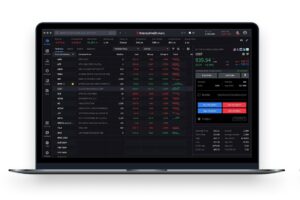Stocks rallied first on Wednesday afternoon, with the S&P 500 (US500) and Dow Jones (US30) rising to new record highs and the NASDAQ (US100) rising to a 3-week-high. The FOMC’s decision on Wednesday to cut the target range for the federal funds rate by 50 bps and project another 50 bps rate cut before the end of the year pushed stock prices higher. However, stocks later gave up their mid-session gains and moved lower as hawkish comments from Fed Chair Powell pushed bond yields higher and sparked a sell-off in shares of chip companies. As a result, the Dow Jones Index (US30) was down 0.25%, while the S&P 500 Index (US500) fell by 0.29%. The NASDAQ Technology Index (US100) closed negative 0.31%.
The FOMC voted 11–1 to cut the target range for the federal funds rate by 50 bps to 4.75–5.00% and said the committee is “firmly committed to supporting maximum employment” and returning inflation to the 2% target. The market did not expect a 50bp rate cut immediately, but the reaction was rather subdued. Powell tried to reassure participants by explaining that the double cut was not a reaction to economic problems, but rather a catch-up with other central banks and a pre-emptive measure to avoid recession. The FOMC lowered its 2024 US GDP estimate to 2.0% from 2.1% in June and lowered its 2024 core PCE projection to 2.6% from 2.8% in June. The FOMC also raised its 2024 unemployment prognosis to 4.4% from 4.0% in June.
Key talking points from Fed Chairman Jerome Powell’s speech:
- The Fed rate was lowered to 5.00%, compared to market expectations of 5.25%; this is the first Fed rate cut in four years.
- Fed balance sheet reduction (QT) continues as planned.
- Declining inflation and a cooling labor market indicate the need for monetary policy easing.
- The US economy is strong, but since other central banks have already cut rates earlier this year, the Fed may act more aggressively.
- The Fed has kept rates high longer than other central banks, and that has had an effect: lower inflation is on the right trajectory.
- The current 50bp rate cut is not a reaction to the economic problems but a signal that the regulator will not allow a significant deterioration in the labor market and the economy.
It should be noted that on Friday the quarterly expiration of derivatives in the US market will take place, and there is an active transfer of positions to the December expiration. The closing of the current week will be key to determining the medium-term prospects of the markets.
Equity markets in Europe were mostly down yesterday. German DAX (DE40) declined by 0.08%, French CAC 40 (FR40) closed down by 0.57%, Spanish IBEX 35 (ES35) fell by 0.16%, and British FTSE 100 (UK100) closed down 0.68%.
On Thursday, WTI crude oil prices fell to around $70.3 per barrel, declining for the second consecutive session, amid a rising US dollar. While the recent half-point cut in the Fed Funds rate would normally support oil prices, market sentiment was dampened by Fed Chairman Jerome Powell’s statement that the Central Bank would not be in a hurry to ease monetary policy and that the dot plot of the federal funds rate estimate should not be seen as a policy plan.
Asian markets mostly up yesterday. Japan’s Nikkei 225 (JP225) rose by 0.49%, China’s FTSE China A50 (CHA50) gained 0.34%, Hong Kong’s Hang Seng (HK50) added 1.37% and Australia’s ASX 200 (AU200) was positive 0.02%.
The Australian dollar rose to $0.678 as good employment data suggested that the economy remains strong, giving the Reserve Bank of Australia (RBA) room to hold policy. The data showed that the number of jobs in Australia increased by 47,55 in August, well above projections of 25,000. Meanwhile, the unemployment rate remained at its highest level in two and a half years at 4.2%. Markets currently believe that the RBA will not cut interest rates until at least December, with some economists expecting the first move as early as the second quarter of 2025.
The New Zealand dollar rose to as high as $0.621 even after data showed that New Zealand’s economy contracted in the second quarter. Data released on Thursday showed GDP fell by 0.2% in the June quarter, which was better than the RBNZ’s estimate of a 0.5% contraction. On an annualized basis, GDP contracted 0.5%, which was in line with expectations. Markets have now fully priced in the possibility of another quarter-point rate cut in October, and there is a 28% chance of a 50 basis point rate cut.
S&P 500 (US500) 5,618.26 −16.32 (−0.29%)
Dow Jones (US30) 41,503.10 −103.08 (−0.25%)
DAX (DE40) 18,711.49 −14.59 (−0.08%)
FTSE 100 (UK100) 8,253.68 −56.18 (−0.68%)
USD Index 100.95 +0.06 (+0.06%)









